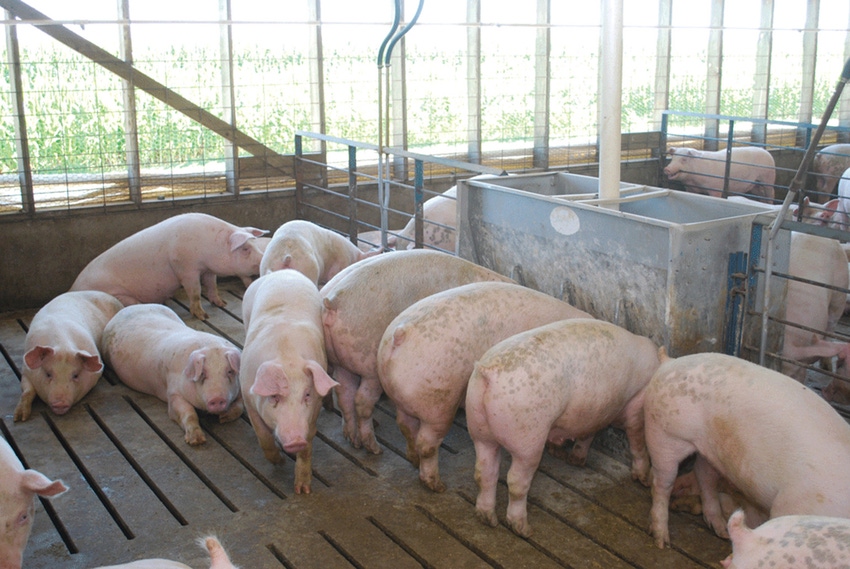4 ways to manage, eliminate PEDV within finishing systems
Uncovering the route of disease introduction into a negative population may be the most important step in PEDV elimination.
August 25, 2017

By Will Fombelle, DVM, Carthage Veterinary Service Ltd. Associate Veterinarian
Porcine epidemic diarrhea virus has continued to greatly challenge the swine industry since its introduction into the American swine herd in May 2013. As we work through PEDV introductions in our wean-finish systems, it is important for producers to recognize that PEDV elimination is possible but does not come without the appropriate planning and execution of necessary procedures. The summer season is a very crucial time to eliminate the virus; we should make the most of the hot summer weather to put ourselves in a position to move into the cold winter months free from PEDV. This column will outline the necessary processes and procedures needed to successfully eliminate PEDV from finishing sites.
Disease investigation
The initial step of most disease elimination strategies is to work-up and uncover the route of disease introduction into a negative population. This may be the most important step in PEDV elimination in order for us to protect future groups of pigs from being exposed to PEDV. Each individual producer or system is different and comes with different associated risks; however by focusing on a common disease investigation, we can routinely reveal the route of disease introduction.
PEDV transmission and introduction has been historically linked to fomites, i.e. any agent that can carry the live virus into a pig population. When we look into potential routes of transmission, we need to focus on any potential fomite that may come into contact with PEDV. This could range from shared labor from sites with active PEDV, vehicle and supply contamination, manure hauling equipment or transport equipment contamination. Again, each system is different and we need to focus on the risks that are associated with our individual sites.
Site isolation and turn-over
As each producer moves through their own PEDV elimination plan, it is crucial to focus on bio-containment and lowering the risk of spreading the disease to any other site within your system or neighboring systems. A common practice today is to develop a biosecurity pyramid of sites and plan out the necessary downtime and requirements for entry into each site. It is very important to plan out timelines of entering a site infected with PEDV, especially if the individual needs to visit multiple sites each day.
A site infected with PEDV should be visited at the end of the day to limit the risk of spreading disease to other barns. If there are multiple barns on the site with differing PEDV statuses, it is important for the site staff to develop a biocontainment plan to limit the risk of dragging the virus into the other barns on site. This plan should include setting up separate boots and coveralls for the infected barn, limiting the use of common equipment between barns, and to chore the affected barn at the end of the day without re-entry to any PEDV negative barns. I would recommend one night downtime and a shower before returning to the site the following day.
Other important risks for producers to manage would be any supplies, tools or materials shared between barns or sites. These materials would include boots and/or coveralls, sort boards or portable load-chutes. These items which are able to be disinfected should be set at room temperature for at least 24 hours after disinfection before movement to another site. All clothing should be machine washed with bleach and dried before additional use. Once a site becomes infected with PEDV, all movement of common supplies should be halted unless proper disinfection and downtime is followed.
Site clean-up
After the site or barn has been marketed and emptied, a proper washing and disinfection plan must be followed. This plan should include intense washing of the barn to ensure that all organic material is removed. Extra attention needs to be placed on areas such as load-out chutes, feeders, water bowls, gating and corners of each barn. Also, common supplies that stay within the barn for multiple turns — sort boards, rattle paddles, brooders and pig mats — should also be washed and disinfected. All of these items need to be washed and disinfected to maintain confidence of eliminating PEDV.
After the site is washed, the site should be inspected by a management team member. Bringing in a second pair of eyes is very important to gain awareness of crucial areas of contamination that may have been missed by the washing crew. This individual should create a checklist of the areas discussed above and walk through the site with an item such as marking chalk to highlight any area that needs to be re-washed before final disinfection. Once the barn has passed inspection and allowed to dry overnight, disinfection may begin.
Disinfection with products that contain quaternary ammonium and glutaraldehyde has been shown to work very well against PEDV. The product should be administered at its proper labeled rate and the barn should also be allowed to dry before bringing any new animals in.
Continuous flow
Contrary to popular belief, PEDV elimination of a continuous-flow barn is quite possible. Significant work needs to be put into pig flow to be able to place pigs into other sites while the remaining pigs on the infected site are exposed to the live field virus. After a new field virus introduction, the site should be placed on hold without new deliveries of naïve animals. Once the pig flow has been suspended, all animals should be naturally exposed to the virus. Four weeks post exposure; fecal swabs should be collected from the populations to determine if the herd has stopped its natural shedding of PEDV. Once negative rectal swabs have been collected, the washing process will begin.
There are reports of PEDV remaining viable in the environment for up to 12 weeks. To reduce the risk of environmental contamination, a complete wash of the barns is necessary. To complete a washing project in a barn that still contains animals, you must start with at least two empty pens at one of the ends of the barn. These two pens will be washed, allowed to dry, disinfected and dried again. Once this process is completed, you are able to move the next pen of animals into the first empty clean pen and keep one clean pen as a buffer between the clean and dirty pens. This process needs to continue until all pens have been washed and disinfected.
To be sure that the virus has been eliminated from the site, individual naïve animals could be placed into the site to serve as sentinel animals. Once these animals have been placed into the site for 72 hours, rectal swabs of these animals should be collected and tested for PEDV by polymerase chain reaction. If these animals test negative for PEDV, then it would be safe to assume that you have eliminated the virus from the environment and new animals are cleared to enter the site once again.
You May Also Like


